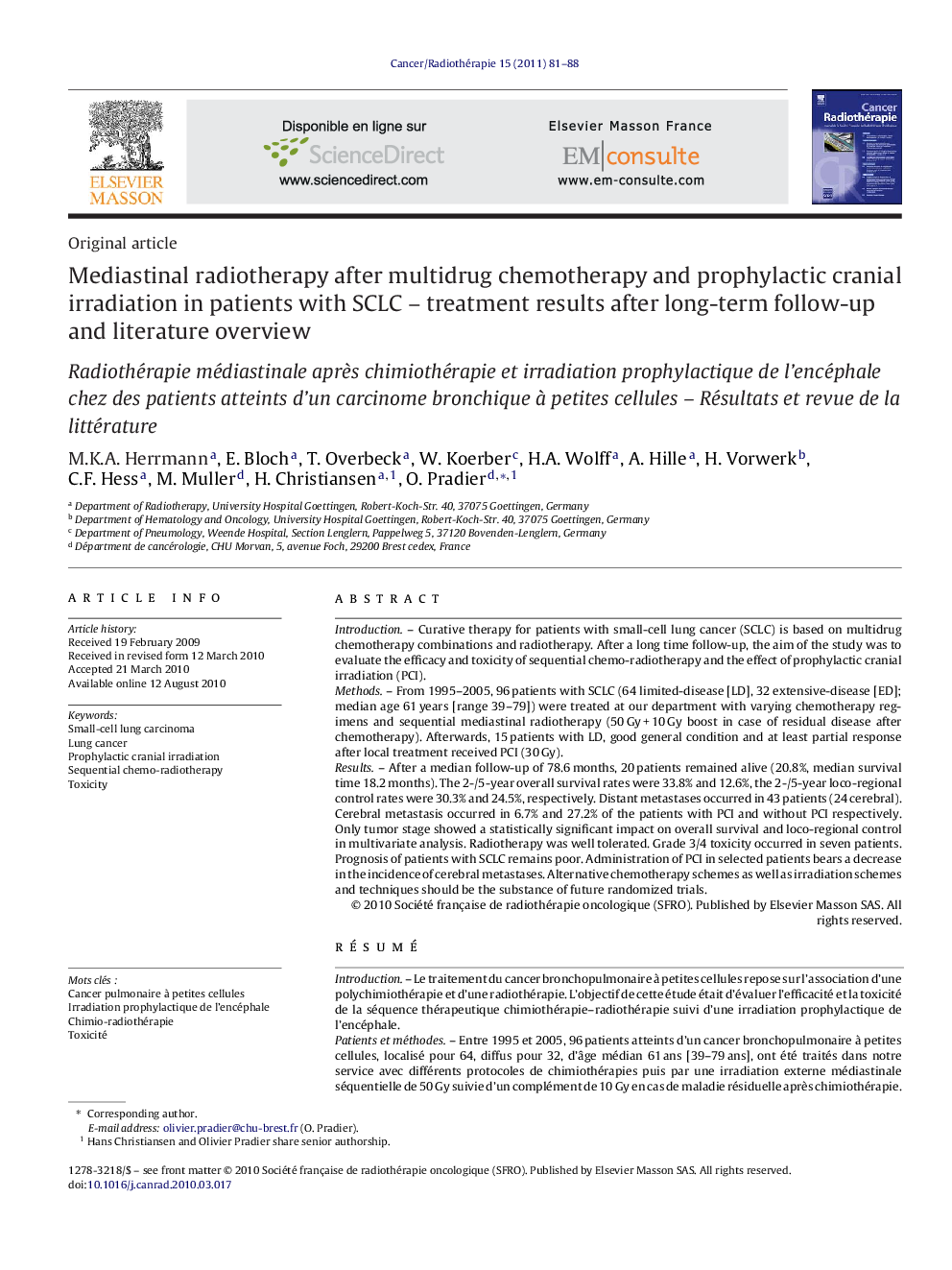| کد مقاله | کد نشریه | سال انتشار | مقاله انگلیسی | نسخه تمام متن |
|---|---|---|---|---|
| 2117831 | 1085214 | 2011 | 8 صفحه PDF | دانلود رایگان |

IntroductionCurative therapy for patients with small-cell lung cancer (SCLC) is based on multidrug chemotherapy combinations and radiotherapy. After a long time follow-up, the aim of the study was to evaluate the efficacy and toxicity of sequential chemo-radiotherapy and the effect of prophylactic cranial irradiation (PCI).MethodsFrom 1995–2005, 96 patients with SCLC (64 limited-disease [LD], 32 extensive-disease [ED]; median age 61 years [range 39–79]) were treated at our department with varying chemotherapy regimens and sequential mediastinal radiotherapy (50 Gy + 10 Gy boost in case of residual disease after chemotherapy). Afterwards, 15 patients with LD, good general condition and at least partial response after local treatment received PCI (30 Gy).ResultsAfter a median follow-up of 78.6 months, 20 patients remained alive (20.8%, median survival time 18.2 months). The 2-/5-year overall survival rates were 33.8% and 12.6%, the 2-/5-year loco-regional control rates were 30.3% and 24.5%, respectively. Distant metastases occurred in 43 patients (24 cerebral). Cerebral metastasis occurred in 6.7% and 27.2% of the patients with PCI and without PCI respectively. Only tumor stage showed a statistically significant impact on overall survival and loco-regional control in multivariate analysis. Radiotherapy was well tolerated. Grade 3/4 toxicity occurred in seven patients. Prognosis of patients with SCLC remains poor. Administration of PCI in selected patients bears a decrease in the incidence of cerebral metastases. Alternative chemotherapy schemes as well as irradiation schemes and techniques should be the substance of future randomized trials.
RésuméIntroductionLe traitement du cancer bronchopulmonaire à petites cellules repose sur l’association d’une polychimiothérapie et d’une radiothérapie. L’objectif de cette étude était d’évaluer l’efficacité et la toxicité de la séquence thérapeutique chimiothérapie–radiothérapie suivi d’une irradiation prophylactique de l’encéphale.Patients et méthodesEntre 1995 et 2005, 96 patients atteints d’un cancer bronchopulmonaire à petites cellules, localisé pour 64, diffus pour 32, d’âge médian 61 ans [39–79 ans], ont été traités dans notre service avec différents protocoles de chimiothérapies puis par une irradiation externe médiastinale séquentielle de 50 Gy suivie d’un complément de 10 Gy en cas de maladie résiduelle après chimiothérapie. Une irradiation prophylactique de l’encéphale de 30 Gy a ensuite été délivrée aux 15 patients en bon état général atteints d’un cancer localisé qui a répondu au moins partiellement au traitement.RésultatsAprès un suivi médian de 78,6 mois, 20 patients étaient en vie (médiane de survie à 18,2 mois : 20,8 %). Les taux de survie globale à deux et cinq ans était respectivement de 33,8% et 12,6%, les taux de contrôle local à deux et cinq ans respectivement de 30,3 % et 24,5 %. Quarante-trois patients ont été atteints de métastases dont 24 cérébrales. Les métastases cérébrales sont apparues respectivement chez 6,7 % des patients irradiés prophylactiquement dans l’encéphale et 27,2 % non irradiés. Seul le stade tumoral a montré un impact significatif sur la survie globale et le contrôle locorégionale en analyse multifactorielle. La radiothérapie a été bien tolérée. Des effets secondaires de grades 3 et 4 sont survenus chez sept patients.ConclusionLe pronostic de patients avec des carcinomes bronchopulmonaires à petites cellules reste défavorable. L’administration d’une radiothérapie prophylactique cérébrale chez des patients sélectionnés apparaît diminuer l’incidence des métastases cérébrales. D’autres protocoles de chimiothérapies ainsi que des schémas et des techniques d’irradiation différentes doivent être testés dans les futurs essais randomisés.
Journal: Cancer/Radiothérapie - Volume 15, Issue 2, April 2011, Pages 81–88